A hero for Scots, a character promoted to the world mainly by Mel Gibson's cult film "Braveheart - Brave Heart". How was the legend of a key figure in the Scottish War of Independence born?
Most readers are probably familiar with the character created by Mel Gibson in the famous 1995 film - a stout warrior with lush hair and a blue painting on his face during a crucial battle.
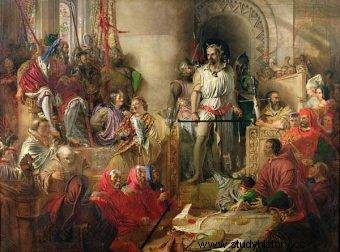
William Wallace, or how the brave hearts of the Scots regained independence
The production was prepared on a grand scale, with great music and a good cast. We should remember, however, that although it is a historical film, it has little in common with history, and the script was based only on the canvas of events and it is somewhat different from the facts. So how was it really?
A way to seize the Scottish throne
The childless and tragic death of the Scottish king Alexander III became the source of the conflict over the leadership of the country. Edward I Long-legged, the ruler of England, tried to match his six-year-old son Edward II with the granddaughter of the late King of Scotland - Margaret (then 3 years old).
He made an agreement with Małgorzata's father - the king of Norway, Erik II - deciding about the marriage of the children (as well as the personal union between England, Scotland and Norway). The wedding did not take place, because the body of the young Margaret could not withstand the hard and difficult journey from the country of the fjords to Scotland.
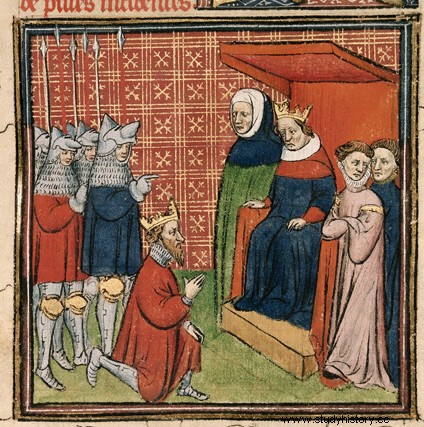
Edward I proposed several claimants to the throne. Eventually, he was taken over by Jan Balliol, a man very devoted and subordinate to the ruler of England.
To prevent a civil war, Edward asked for recognition from the Scottish barons. A council was formed to decide whose hands the crown would go to. Time passed and the council was unable to select a suitable candidate. In such a situation, Edward I proposed several claimants to the throne. Eventually, he was taken over by Jan Balliol, a man very devoted and subordinate to the ruler of England.
Hammer of the Scots
Edward used Scotland as a kind of granary and financial base during the war with France, which lasted until 1295. In the same year, the Scots made an alliance secretly with the King of France - Philip IV the Beautiful.
Information about behind-the-scenes conversations with the French reached Edward's ears. Thus, in the spring of 1296, a new conflict began. The fighting continued until the end of June, King John was compromised and imprisoned in the Tower of London, and Edward was nicknamed The Hammer of the Scots (e.g. because he took the coronation stone of the kings of Scotland to the Westminster Abbey, and also publicly destroyed the royal seal). Scotland was deprived of its status as an independent kingdom.
Brave heart
It was not easy for the Scots - onerous taxes, compulsory conscription and the ubiquitous English army made life in the north of the island unbearable. This is where William Wallace - the future national hero - appears in the history books.
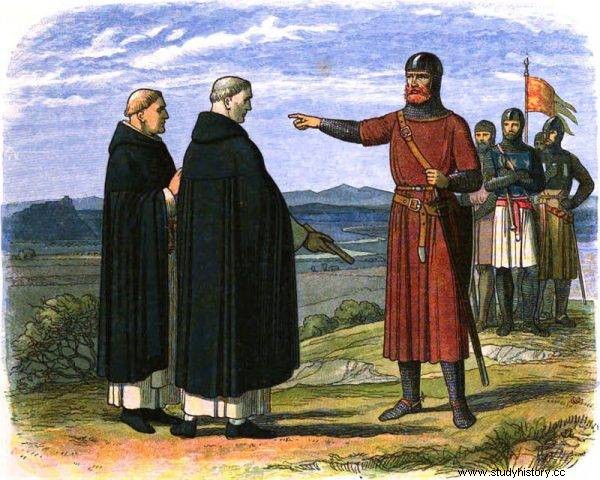
William Wallace rejects the proposal of the English MPs
It is worth noting that there is very little information about William's early life. He was born around 1270 (the exact date is unknown, most often the years are 1270 or 1272), he was the son of the landowner Alan and had two brothers:Malcolm and John.
According to the most famous story, was to be elected leader of the uprising against England after the murder of Sheriff William Heselrig , responsible for the death of the woman married to Wallace - Marion Braidfute.
In Scotland, revolts and revolts broke out here and there. William, together with a group of Scottish insurgents, launched an attack on the well-protected English garrison in Scone (a very symbolic place, because it was associated with the coronations of Scottish kings; there was an enthronement stone in the abbey here, which was robbed by Edward I).
After the rally, most of the group was captured. William managed to escape and joined forces with Andrew de Moray (one of the leaders of the Scottish Uprising) for victory in the upcoming Battle of Stirling.
Battle of Stirling
Wallace became the commander-in-chief of an uprising against King Edward's forces. From the spring of 1297, attacks on English troops located in garrisons, castles and villages took place in various parts of the country. More and more people in the northern part of the island joined the Scottish army that was forming below. After tough battles in the summer months, the Scots managed to take over key places - Perth, Aberdeen and Dunnotar.
King Edward was at that time preparing a military expedition to the territory of the Flanders county (today the region of Belgium, the Netherlands and France). After receiving information that there was a growing independence uprising in Scotland, he sent the Governor of Scotland and the Royal Treasurer (who by their way did not like each other) to establish relative order and peace.
At the end of the summer of 1297, they left Berwick with a guard of about 11,000. people - walkers, heavy-armed and archers - towards Stirling to strengthen the garrison of the castle there. They thought it would be very easy to win over the Scots.
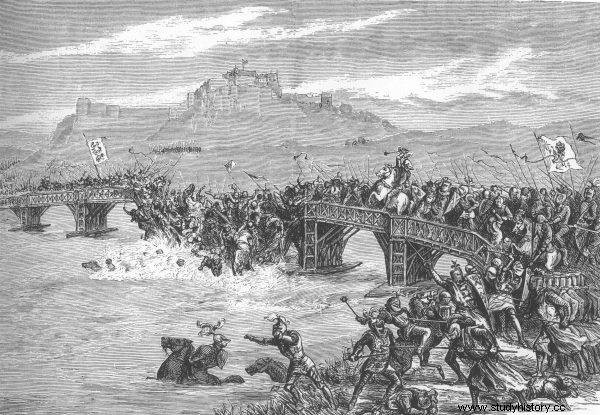
Battle of Stirling
William Wallace was reorganizing the military at that time. From the vicinity of Perth he set off with an army of 10-16 thousand. lightly armed walkers and about 150-200 horsemen. In early September, Wallace arrived in the vicinity of Striling. It was located in the hills around the castle, from where it had a great view of the valley, the river and a narrow wooden bridge near the walls.
The English tried several times before the battle to diplomatically convince the Scots to surrender (they probably feared for their position - an uphill attack awaited them, a crossing over a narrow bridge and a possible fight on marshy ground). In the end, however, it was decided that the English army would go over the bridge and start the clash.
At noon on September 11, about half of the English forces were on the other bank. William Wallace ordered the attack. The opponents were unprepared and terrified. The Scots were rushing from the surrounding hills to the sheltered enemy lines. They quickly cut off the rest of the army, which watched in fear at the slaughter of the troops on the other side of the river. She was unable to help them because the bridge collapsed.
Only a few managed to swim to the other side, saving themselves from the bloody shambles. Ultimately, the battle was won by William, and the remnant Edward's forces were forced to retreat to Berwick. The losses on the English side were huge.
Knighthood, defeat and the fall of the uprising
By the end of October 1297, virtually all of Scotland had managed to get rid of the English from the garrisons they occupied. The victory at Stirling was crucial. William Wallace recognized the authority of King John, and as a reward for expelling English forces, he was knighted in March 1298 and made guardian of the kingdom. In fact, it was William who ruled Scotland on behalf of the King, still trapped in the Tower of London.
In 1298, Edward's regrouped troops reappeared in Scotland. Wallace tried to avoid a major battle; his tactic was to allow the English to travel deep into the country to attack their troops by surprise or over rough terrain. The streak did not last long, however, Edward managed to attack the unprepared Scottish forces at Falkirk, where the English defeated the Scots. William almost died in the clash, but managed to escape the ambush.
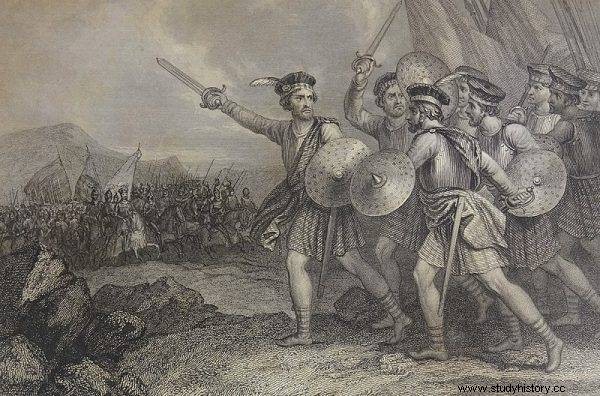
William Wallace recognized the authority of King John, and for his displacement of the English forces he was made a knight
In the following years, William probably sought the protection of Philip IV the Beautiful, and in the meantime he fought fierce battles with the English, although a large part of the Scottish nobility went to Edward's side. In 1305 he was captured near Glasgow by his compatriot Jan Menteith.
Lonely and discredited, he was taken to London. He was accused of treason, murder, sacrilege and sentenced to death by hanging and dismemberment. The sentence was carried out on August 23, 1305. The head was stuck on the Tower, the rest of the body was sent to Scotland and England and placed in distinctive places.
After William Wallece's death, the country rebelled again, which finally ended the War of Independence with a victory for the Scots. William became a national hero, his story was told in many poems, and his fame awakened a nascent national consciousness. In the 19th century, a monumental monument commemorating William and the battle itself was built near the skirmish site at Stirling. Mel Gibson also made a contribution.
Bibliography:
- Barron E., Scottish War of Independence , Oświęcim 2016.
- Brown C., William Wallace. The True Story of Braveheart , 2005.
- Fisher A., William Wallace. Scotland's Brave Heart , 2011.
- Kapitaniak T., History of Scotland , Łódź 2000.
- Wojtczak J., Bannockburn 1314 , Warsaw 2003.
